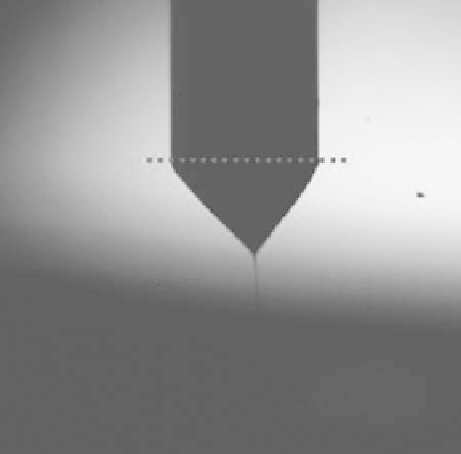Biomedical Engineering Reference
In-Depth Information
400
µ
m
FIGURE 11.2
A photograph of the cone-jet electrospraying pattern. (Reprinted from Samarasinghe, S.R. et al.,
Gold Bull
., 39, 48, 2006. © World Gold Council. With permission.)
Therefore, the applied voltage accelerates the surface charge toward the cone apex so that a jet with
a high charge density will be formed at the cone apex. Figure 11.2 shows a diagram of a cone-jet
electrospraying pattern. The liquid at the conical tip is emitted into a fi ne jet, which then becomes
unstable and breaks up into a mist of fi ne aerosol droplets. The aerosol droplets repel each other
vigorously, as they are highly charged with the same electrical charge. Consequently, the droplets
break into a number of primary and secondary droplets. Electrospraying is a technique used to
atomize a liquid solution into charged fi ne droplets, which allows the generation of aerosol droplets
with a controllable droplet size in a narrow size distribution [15].
11.2.2 B
ACKGROUND
Rayleigh derived the phenomenon and theory of atomization of liquids into small charged droplets
by an electrostatic fi eld a hundred years ago [16]. He found that a charged droplet is unstable and
causes the Coulomb fi ssion of the liquid droplet into smaller droplets when the electrohydrody-
namic forces caused from the electrostatic charges overcome the balance of the surface tension
forces. There is a maximum limit of surface charge density, termed the Rayleigh limit. The relation-
ship between the maximum charge,
Q
R
, on a droplet and the size of a droplet,
d
, can be described
as follows [17]:
8 π(
ε
0
σd
3
)
1/2
Q
R
=
(11.1)
where
ε
0
is the dielectric constant of the liquid and
σ
is the surface tension of the liquid.
Zeleny was the fi rst researcher to study the electrospraying phenomenon systematically using
a capillary-plate experimental confi guration in 1917 [18]. He experimented with different electro-
spraying modes, including the dripping mode, cone-jet mode, and multijet mode with ethanol and
glycerin. He was also the fi rst person to take photographic images of electrospraying and provide
the fi rst solid scientifi c description of the process. However, Zeleny did not establish the general
rules for boundary values of the processing parameters, such as electrical conductivity, surface
tension, and viscosity of electrosprayed solution, as these parameters affect the electrospraying


